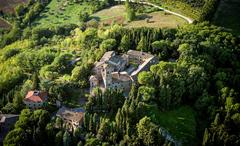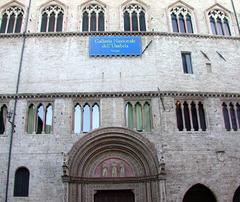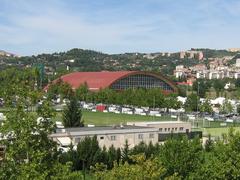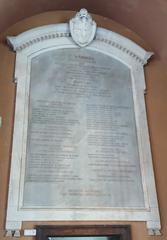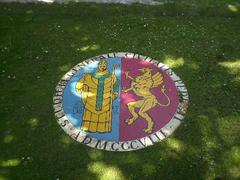Rocca Paolina Perugia: Visiting Hours, Tickets, and Historical Site Guide
Date: 04/07/2025
Introduction
Rocca Paolina, nestled in the heart of Perugia, Italy, is one of the city’s most evocative historical sites. Built between 1540 and 1543 by order of Pope Paul III and designed by Antonio da Sangallo the Younger, this fortress was a direct response to the city’s rebellion during the War of the Salt. Its construction dramatically altered Perugia’s landscape, razing entire neighborhoods, medieval towers, and churches—most notably those belonging to the Baglioni family—to assert papal dominance. While the above-ground fortress was largely demolished during the 19th-century unification of Italy, the atmospheric underground city remains: a labyrinthine network of vaults, passageways, and remnants of medieval streets preserved beneath modern Perugia.
Today, Rocca Paolina is more than a historical monument. It is a vibrant cultural hub that hosts exhibitions, artisan markets, and seasonal events. Its extensive escalator system not only connects key parts of the city but also offers visitors an immersive journey through centuries of Perugia’s layered identity. This guide details Rocca Paolina’s visiting hours, ticketing, accessibility, nearby attractions, and insider tips to help you fully appreciate this iconic Perugia landmark.
For in-depth resources and further reading, consult articity.it, try-travel.com, and Life in Italy.
Table of Contents
- Origins and Historical Context
- Architectural Features
- Visitor Information
- Cultural & Symbolic Significance
- Events & Exhibitions
- Practical Tips for Visitors
- Frequently Asked Questions (FAQ)
- Nearby Attractions
- Conclusion
- Sources and Useful Links
Origins and Historical Context
Papal Authority and the War of the Salt
Rocca Paolina’s roots lie in the 16th century when Perugia’s independent spirit clashed with papal ambitions. The imposition of a salt tax by Pope Paul III sparked the War of the Salt in 1540. After quelling the rebellion, the Pope commissioned the fortress to cement papal power and stifle future dissent. The construction, led by Antonio da Sangallo the Younger, involved the destruction of entire neighborhoods, churches, and the homes of the Baglioni family—Perugia’s former rulers (articity.it).
Transformation and Demolition
The fortress loomed over Perugia for three centuries, a symbol of external rule and oppression. In the 19th century, the tides shifted: after Perugia joined unified Italy, the citizens demolished most of the fortress, leaving only the subterranean vaults. Restoration in the 20th century uncovered these underground streets, which now form the evocative “underground city” so integral to Perugia’s urban landscape (goaskalocal.com).
Architectural Features
Subterranean City: Vaults and Passageways
The most striking aspect of Rocca Paolina today is its underground network. Visitors traverse robust stone vaults, high arches, and atmospheric corridors that once allowed troops safe passage and now house remnants of medieval streets and homes (articity.it).
Porta Marzia: Etruscan Heritage
Integrated into the fortress walls is the ancient Etruscan Porta Marzia, dating back to the 3rd century BC. This travertine gate, adorned with statues and Roman inscriptions, was preserved by blending it seamlessly into the new Renaissance structure, symbolizing the continuity of Perugia’s history (articity.it).
Modern Adaptations
In 1983, escalators were installed to connect Piazza Partigiani and Piazza Italia, making Rocca Paolina a vital urban artery as well as a historical site (articity.it). The underground vaults host art exhibitions, artisan markets, and cultural events throughout the year (ibnbattutatravel.com).
Visitor Information
Location and Access
- Address: Piazza Italia, Perugia, Italy.
- Access Points: Four main entrances, including Porta Marzia and escalators from Piazza Partigiani.
- Public Transport: Adjacent to bus stops and taxi ranks; the MiniMetro connects the train station to the city center, a short walk from Rocca Paolina (UmbriaConMe).
Visiting Hours
- Underground Passages: Open daily from 06:15 to 01:45, in line with escalator hours (Visit Italy; Nomads Travel Guide).
- Exhibition Spaces (C.E.R.P.): Usually Tuesday–Sunday, 11:00–19:00. Check for special events.
Tickets and Admission
- Underground Fortress: Free entry (Life in Italy).
- Special Exhibitions: Some events may require tickets; check CERP or the official Perugia tourism calendar.
Accessibility
- Escalators and ramps provide access for visitors with limited mobility, though some historic sections have uneven floors. Wheelchair users are advised to check ahead (Visit Italy).
- Signage is in Italian and English; staff often speak basic English.
Facilities
- Restrooms: Found near main entrances.
- Shops/Cafés: Not inside the fortress, but abundant in nearby Piazza Italia.
- Wi-Fi: Available in some city areas, but may be inconsistent underground.
Cultural & Symbolic Significance
Rocca Paolina is more than a relic; it is woven into Perugia’s civic life. Hosting art shows, concerts, and events such as the Umbria Jazz Festival (umbriajazz.it), it serves as a symbol of resilience and transformation. Its layered spaces—Etruscan, medieval, Renaissance, and modern—invite reflection on the city’s turbulent history and enduring creativity (try-travel.com; umbriatourism.it).
Events & Exhibitions
- Art Exhibitions: Hosted regularly at C.E.R.P. and within the fortress’s underground halls (Porta Perugia).
- Cultural Festivals: Rocca Paolina is a venue for events like Umbria Jazz and Eurochocolate (UmbriaEventi).
- Christmas Markets: The fortress becomes a magical marketplace during the holiday season.
- Guided Tours: Offered through local tourism offices, providing deeper historical context (UmbriaConMe).
Practical Tips for Visitors
- Footwear: Wear sturdy, non-slip shoes; floors can be uneven and cool even in summer.
- Best Time to Visit: Spring and early autumn for mild weather and festivals; Christmas and October for unique events (Michelle Cajia).
- Photography: Allowed throughout; the underground lighting offers excellent photo opportunities.
- Duration: Allocate 1–2 hours for a thorough visit.
- Language: Most signage is bilingual; learning basic Italian can enhance your experience.
Frequently Asked Questions (FAQ)
Q: Is there an entrance fee?
A: The underground passages are free to enter. Some exhibitions or events may require tickets.
Q: What are the opening hours?
A: Daily from 06:15 to 01:45, matching the city’s escalator hours.
Q: Is Rocca Paolina accessible for wheelchair users?
A: Most areas are accessible via escalators and ramps, but some historic sections may be challenging.
Q: Are guided tours available?
A: Yes, bookable through local tourism offices or online.
Q: Can I take photographs inside?
A: Yes, and it is encouraged.
Nearby Attractions
- Piazza IV Novembre & Palazzo dei Priori: Perugia’s main square and civic palace.
- National Gallery of Umbria: Rich collection of Umbrian art.
- Etruscan Arch (Arco Etrusco): A monumental city gate.
- Corso Vannucci: Main street with shops, cafés, and vibrant local life.
- Giardini Carducci: Scenic gardens near Piazza Italia. (Life in Italy; Tourist Places Guide)
Conclusion
Rocca Paolina is a testament to Perugia’s resilience, ingenuity, and vibrant culture. Its underground passages invite exploration of a city layered with Etruscan, medieval, and Renaissance history. With free entry, extended hours, and a lively calendar of events, it offers something for every traveler—whether you’re a history enthusiast, a culture lover, or simply seeking a memorable experience beneath the streets of Perugia.
Ready to explore Rocca Paolina? Download the Audiala app for guided tours, event alerts, and exclusive content to enhance your visit. Stay connected via our social channels for updates on Perugia’s historic treasures.
Visuals & Media Suggestions
Sources and Useful Links
- Rocca Paolina: Visiting Hours, Tickets, and History of Perugia’s Iconic Fortress – Articity
- Rocca Paolina: Visiting Hours, Tickets, and Exploring Perugia’s Historic Fortress – Try Travel
- Rocca Paolina Visiting Hours, Tickets, and Events – Life in Italy
- Rocca Paolina Visitor Guide – Visit Italy
- Umbria Jazz Festival Official Site
- Umbriatourism Official Site
- Nomads Travel Guide – Rocca Paolina
- UmbriaConMe – Visiting Rocca Paolina
- Michelle Cajia – Perugia Travel Tips
- Viadelvino – The Story of Perugia’s Rocca Paolina
- GoAskALocal – Perugia Travel Guide
- Porta Perugia
- Tourist Places Guide – Perugia
- Triphobo – Rocca Paolina
- UmbriaEventi
- ibnbattutatravel.com
- Italia.it – Rocca Paolina
